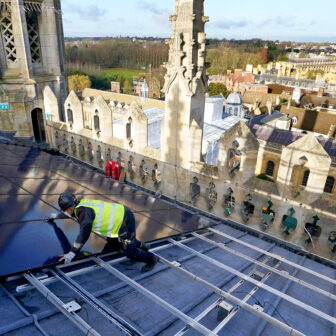In the end COP28 finished only twenty-four hours after its scheduled close, a mere moment compared with last year’s forty-hour marathon. COP president Sultan Al Jaber of the United Arab Emirates, who had been under considerable pressure throughout the conference, looked relieved as he brought the gavel down on the final agreement. Exhausted delegates gave him, and themselves, a standing ovation — apart from the minister from Saudi Arabia, who remained seated, stony-faced. It was perhaps the surest indication of how the agreement should be judged.
During the preceding two days an agreement had by no means been guaranteed. After two weeks of negotiation, the core issue, on the future of fossil fuels, was deadlocked. On the one side were around one hundred small island states, developing countries and EU members, plus Australia, insisting that fossil fuels must ultimately be phased out. Anything less would be “signing our death certificate,” as Samoan natural resources and environment minister Cedric Schuster put it. On the other side were the petrostates and China. Rallied by an instruction from the secretary-general of OPEC, subsequently leaked, they were determined to hold out against any language committing the world to ending fossil fuel production. This would spell, they claimed, their own economic demise.
There are three ways for negotiators to overcome polarised conflict of this kind, and all three were duly used in the final text.
First, find another verb. If “phased out” is not acceptable to one side and “phased down” to the other, the negotiators will have tried alternatives. “Eliminate,” “end the use of,” “take urgent and rapid action towards the alternative”… Ultimately, it was “transition away from” that proved acceptable to all sides. The key sentence in the final agreement reads:
28 (d): Transitioning away from fossil fuels in energy systems, in a just, orderly and equitable manner, accelerating action in this critical decade, so as to achieve net zero by 2050 in keeping with the science.
Linguistic style is not a COP concern.
Second, include several subtly different paragraphs covering the same topics. That way the different sides can each find some text to suit their needs. Immediately before the clause above is this one, which makes essentially the same point, but not quite:
28 (c): Accelerating efforts globally towards net zero emission energy systems, utilizing zero- and low-carbon fuels well before or by around mid-century.
And a little later:
29: Recognizes that transitional fuels can play a role in facilitating the energy transition while ensuring energy security.
In UN-speak, “transitional fuel” means gas, so this clause gives comfort to the gas producers, whatever else is included about transitioning away from fossil fuels.
Third, employ “constructive ambiguity.” Find terms that can mean different things to different audiences, allowing each to claim that it says what they want it to. The key term here is “energy systems.” This is ambiguous: does it just cover power, heating and cooling, which is what most people would say constitutes a country’s “energy system”? Or does it include energy used in transport?
The uncertainty is critical, because if transport is not included, this is not a fossil fuel phase-out. In particular, it would let the oil producers off the hook, since oil is the primary transport fuel. Expect the petrostates to argue that that is indeed what it means — and they will point to a separate clause about transport to support their case. (Why have one of those if this already includes transport? But see point two above.) Meanwhile the advocates of phase-out will say that this is evident nonsense.
If the agreed text can be read in different ways, what does it mean? There isn’t in fact much doubt about this, as the Saudi minister’s expression revealed. The UNFCCC’s official press release spelled it out: the agreement “signals the beginning of the end of the fossil fuel era.” The petrostates had their interpretable clauses — “a litany of loopholes,” said the Alliance of Small Island States — but Team Phase-out had definitely won.
Does it matter, though? There’s a good case for saying no. This text is not binding on anyone. It is the outcome of the Global Stocktake, or GST, an assessment process mandated by the 2015 Paris agreement to guide the national targets and plans that will actually do the emissions cutting. On the Paris five-year cycle, these Nationally Determined Contributions, or NDCs, must be delivered in 2025. The GST text is meant to be heeded when countries set out those plans, but in truth it can be ignored if they so wish. The new NDCs will be for 2035 and 2040, some time before phase-out is meant to happen.
But there’s another way to look at it. Odd as it sounds, this is the first time that any UNFCCC text has mentioned fossil fuels. They’ve been the effective elephant in the room. Every other kind of goal has been used: a temperature limit (2°C above pre-industrial times, then 1.5°C); an emissions target (net zero by 2050); a renewable energy aspiration (the COP28 text specifies a tripling by 2030). COP26, two years ago, finally managed to single out (unabated) coal, and called for its phase-down. But the petrostates had always resisted the naming of fossil fuels as a whole.
This really is where the rubber hits the road. It simply isn’t possible to limit warming to 1.5°C, or cut emissions to net zero, without more or less eliminating the production and consumption of all fossil fuels. It’s only “more or less” because some can be abated through carbon capture and storage technologies, or biological sequestration, or — though we don’t know how to do this at scale yet — the direct drawing down of carbon from the air. But the essential point stands: a safe climate means pretty much phasing out fossil fuels.
In this sense the real impact of the COP28 agreement will not be so much on the immediate behaviour of fossil fuel producers as on the longer-term global debate about energy policy. It will become harder, in short, to argue for an expansion of fossil fuel exploration and mining. If the world has agreed to phase out fossil fuels, how can a new coalmine, or a set of new oil and gas drilling licences, be justified?
Phasing out may not mean the immediate abandonment of fossil fuel production — on the contrary, the COP28 call is for a “just, orderly and equitable” transition — but it surely cannot mean finding and extracting more of the stuff. As the International Energy Agency has made clear, currently exploited reserves hold more than enough carbon to meet the global carbon budget allowable for a 1.5°C world. There is no space for any more.
Of course, changing the debate doesn’t guarantee that the case will be won. But UN textual agreements could never do that. The Paris agreement itself can’t do that — it is founded on the principle of national sovereignty over climate policy. (That’s why there is an “emissions gap” between the aggregate of national emissions commitments and the total that would be needed to limit warming to 1.5°C.) But the terms of the debate do matter. Before 2013 there was no articulated concept of “net zero” emissions. But within eight years every major economy was committed to a net zero target. In very few major countries can an electable politician say they’re not in favour of reaching net zero. In time, the phase-out of fossil fuels may come to have the same political power. And that will then change how fossil fuel policies are made.
The focus in Dubai was all on the production side because the producers were in the room. Fossil fuel phase-out is going to be genuinely difficult for many countries, particularly those highly dependent on coal, oil and gas for export revenue. Australia provides a case in point. Poorer countries in this group — Nigeria, Angola, Mozambique — will demand that the developed world help them make the transition; they were angry there was not more in the COP28 text obliging this. But the real work of phase-out is going to be done on the demand side. Consumers are going to require less.
This is already happening. From the start of the Industrial Revolution, Britain spent nearly 250 years burning coal; today it has more or less been eliminated from the UK power grid. Around 80 per cent of all global investment in electricity production now goes to renewables, grids and storage. In Europe electric heat pumps are beginning to make inroads into gas-based heating systems. On a lifetime basis electric vehicles will be cheaper than petrol and diesel ones within two or three years. The first ships to run on green hydrogen and ammonia are now in production. It’s only really in aviation, where biofuels are not yet viable at scale, that it is hard to see how demand for fossil fuels will fall. The transition has already started.
And we know how it works. Scientists and engineers develop new green technologies. They start out being very expensive, so governments subsidise them. As more are produced, innovation and scale reduce their costs. Governments then mandate a proportion of total supply to take a green form. This creates increased demand for the technology, leading to more innovation and economies of scale and a further reduction in costs. As costs fall, government targets can be raised. Gradually a tipping point is hit where the green technology is cheaper than its fossil rival, and the subsidies become unnecessary. As the capital stock gradually turns over, the green transition becomes complete.
This is precisely the story we have seen in solar and wind power and batteries, where since 2010 costs have fallen around 85 per cent, 55 per cent and 85 per cent respectively. A similar fall in costs can be seen in electric vehicles, and heat pumps will follow. There is a virtuous circle connecting policy, innovation and scale.
The real question, however, is of speed. Had the world started acting seriously on climate change when it was first understood in the 1990s (the initial assessment report of the Intergovernmental Panel on Climate Change was published in 1990), a gradual path could have been followed to a low-carbon future. But it has really only been since 2008–10 that climate policy around the world has become serious. Atmospheric concentrations of greenhouse gases are therefore much higher than they would otherwise have been, and we need to get to net zero more quickly.
This tardiness has made the required trajectory of emissions reduction very steep: the IPCC calculates that, for a 1.5°C pathway, emissions in 2030 need to be cut to around half of their 2019 levels. In turn this has made the politics of transition much more difficult. It would have been hard to replace a coal, oil or gas industry over a period of fifty years. Doing it over twenty-five will stretch governments to the maximum. Many will surely baulk at the prospect.
This then is what the next two years will be about. COP28 has provided the guidance. COP30 in 2025 is when governments must publish their targets and plans. There will of course be a COP between the two: there always is. COP29 will be in the even more improbable location of Baku, capital of Azerbaijan, another oil producer. But it won’t have very much to do. The real focus turns to the city of Belém in northeastern Brazil, gateway to the Amazon, in November 2025. The beginning of the end has begun. •




